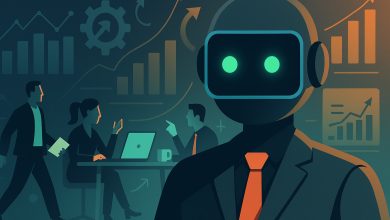Artificial intelligence (AI) is changing how businesses run—and fast. But one fear keeps coming up: Will AI take people’s jobs? For many companies, the answer is no. Instead of firing employees, these businesses are using AI to save time and money, and then reinvesting those savings into growth, innovation, and better jobs for their teams.
This “AI Dividend” is what happens when a company makes more money or saves big by using AI tools. But instead of cutting staff, they use the extra funds to grow smarter and move faster. Let’s explore how this works in real life and how leaders like Justin Herring, Cyrus Partow, and Yarden Morgan are showing us what’s possible.
AI is a Multiplier, Not a Replacement
AI doesn’t have to be about doing more with fewer people. It can be about doing more with the same people—just faster, smarter, and with better results. In businesses large and small, AI tools are helping teams write emails, sort data, analyze customer feedback, and even create marketing plans in minutes instead of hours.
For example, a customer service team that used to handle 100 tickets per day can now handle 300, thanks to smart AI chat tools. But that doesn’t mean fewer jobs. It means happier customers, more revenue, and less burnout for the team. The company can then reinvest those AI savings into training, bonuses, or new hires to support bigger goals.
It’s not about replacing people. It’s about empowering them. AI becomes a force multiplier helping humans do their jobs better, not taking them away.
“We’ve embraced AI tools in our workflows at YEAH! Local, not to cut back on our team, but to scale results,” says Justin Herring, CEO of YEAH! Local.
“I’ve been in this game over 15 years, and what I’ve seen is that AI lets us focus on strategy while handling the grunt work automatically. That means our team can spend more time with clients and testing creative ideas that actually move the needle. Our SEO results are up, clients are happier, and our people feel more valuable than ever. We’re not replacing anyone we’re giving them superpowers.”
Reinvesting in What Matters Most
When companies save time and money using AI, they’re faced with a choice: cut costs and pocket the profit, or reinvest in people and the future. The most forward-thinking leaders are choosing the latter.
One example is a tech startup that used AI to automate its product research. Instead of laying off analysts, they used those savings to fund a new customer success team. Now, customer retention is up 40%. That’s real growth, powered by reinvestment.
AI can also free up time for learning. Some companies are using the time saved to offer weekly “innovation days,” where employees explore new skills or test out fresh ideas. Others are reinvesting in tools and training to help their team grow along with the tech.
“When we built ShipTheDeal, we leaned heavily on AI from day one to keep things lean—but that didn’t mean hiring less,” says Cyrus Partow, founder of the fast-growing e-commerce platform.
“Instead, we used the savings to bring on talented remote team members, train them in SEO, and give them room to grow. I’ve seen firsthand how AI helps us work smarter, but it’s the people who make the magic happen. We’re building a business with heart, not just algorithms. Growth and human touch don’t have to be opposites.”
Creating More Value Through People + AI
The companies winning today are those that blend people and AI into a single force. AI is great at crunching numbers and answering repetitive questions. But humans bring creativity, empathy, and judgment. Together, they unlock new value.
In marketing, AI can draft emails or generate ideas. But a human editor knows what will make the message resonate with a specific audience. In sales, AI can predict leads, but it’s the salesperson who closes the deal with trust and personality.
A growing number of companies now design their AI workflows to include humans at every step. That way, they keep the personal touch while scaling like never before. This hybrid approach doesn’t just avoid job cuts—it creates entirely new roles that didn’t exist a few years ago.
“At Lusha, we’re seeing firsthand how AI and human intuition go hand in hand,” says Yarden Morgan, Director of Growth.
“We use AI to analyze lead data and generate insights, but it’s our people who turn those insights into action. I come from the startup world and even the scouts—so I value teamwork. When AI handles the heavy lifting, our sales and marketing teams can focus on building real relationships. It’s not about replacing roles—it’s about evolving them.”
Trust, Training, and Long-Term Thinking
The best AI strategies don’t happen overnight. They require trust, thoughtful planning, and long-term thinking. Smart leaders are bringing their teams along for the ride, offering clear communication, training, and the space to experiment.
One growing trend is “AI champions”—employees who lead the charge in testing new tools and teaching others. By putting the power in people’s hands, businesses build trust and increase adoption. Teams feel like part of the future, not victims of change.
This shift isn’t just good for morale. It’s good for the bottom line. Companies with empowered teams move faster, solve problems more creatively, and adapt better to whatever comes next. That’s a competitive edge no machine can replicate.
In conclusion, the “AI Dividend” isn’t about cutting corners. It’s about scaling up, doing better work, and building stronger teams. The companies thriving today aren’t firing people—they’re firing up their people. By using AI to save time and money, and then reinvesting that value in growth, learning, and relationships, they’re showing us what’s possible in the age of intelligent business.
As leaders like Justin Herring, Cyrus Partow, and Yarden Morgan prove, success isn’t just about the smartest tech. It’s about the smartest people using it.




